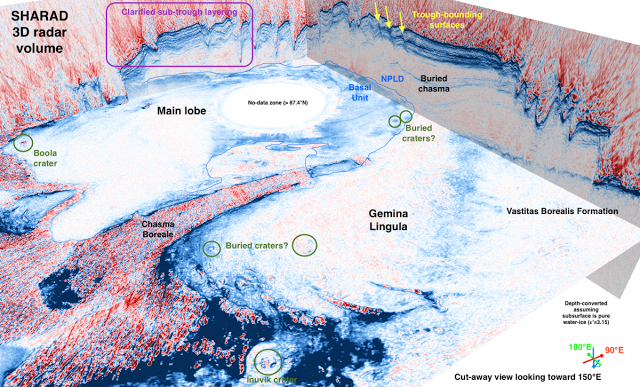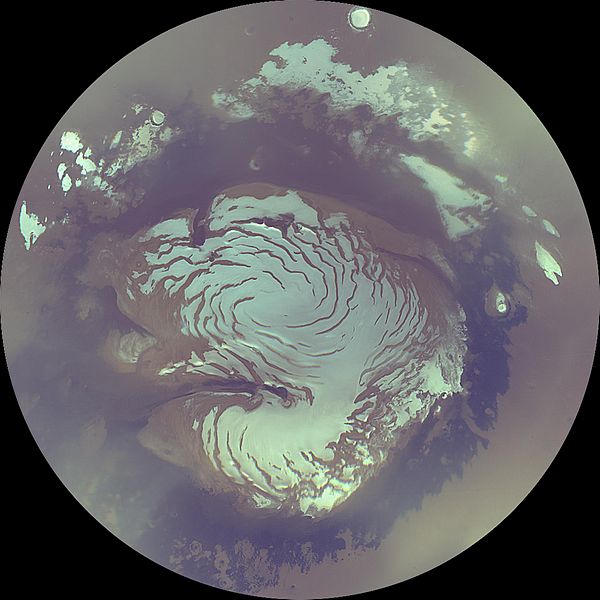

| Online: | |
| Visits: | |
| Stories: |

| Story Views | |
| Now: | |
| Last Hour: | |
| Last 24 Hours: | |
| Total: | |
3-D Images Reveal Features of Martian Polar Ice Caps
“We have applied industry-developed techniques in a very novel fashion to a Martian dataset, producing 3-D volumes that are each over 600 times larger than any terrestrial or planetary dataset of this kind,” said Nathaniel E. Putzig, a Senior Scientist at the Planetary Science Institute and co-author of “3-D Imaging of Mars’ Polar Ice Caps using Orbital Radar Data” that appears in a special section on remote sensing in the January issue of “The Leading Edge.”
This cut-away view shows radar return power (blue high, red low) from features within Planum Boreum, the Martian north polar cap. The depth-converted 3-D volume of SHARAD data encompasses all of Planum Boreum. For scale, the no-data zone is 310 km across and the stack of NPLD layers to the right of the buried chasma is 2 km thick.

Credit: NASA/ASI/JPL/FREAQS/PSI/SI/WUSTL.
“This work literally adds another dimension to the SHARAD data beyond what has been available to planetary scientists in the past,” said Frederick J. Foss of Freestyle Analytical & Quantitative Services and lead author on the paper. “While 3-D seismic and ground penetrating radar have become routine tools in terrestrial geophysical exploration, our 3-D treatment of the SHARAD data is a first in planetary geophysical exploration. The 3-D imaged SHARAD volumes significantly enhance the detectability and interpretability of features within the Martian polar ice caps.”
Layering seen at the surface of the Martian polar caps has been studied for decades. It has long been thought to represent a record of climate changes on that planet. The interior structures of the caps remained a mystery until the arrival of radar sounders at Mars in the last decade.
Previously, many important discoveries were made through analysis of data from collections of SHARAD single-orbit profiles despite their inherent limitations. 3-D data products now exist for nearly the entire volume of polar-cap interiors.
An early version of the north polar 3-D volume helped to assess the quantity of water ice transferred to the polar caps in the most recent retreat from a Martian ice age. First looks at the south polar 3-D volume indicate that previously mapped deposits of carbon dioxide ice are somewhat larger than reported. In both polar 3-D volumes, known impact craters in and near the polar caps that are partially filled with ice have distinctive bowl-shaped signatures in the radar data, and similar signatures are found elsewhere within the polar ices but without any surface expression. Whether the latter structures truly are impact craters remains to be determined.
Age estimates of planetary surfaces throughout the Solar System rely on statistical data for impact craters on the Moon’s surface calibrated to radiometrically dated samples returned during the Apollo program. This method has been used to estimate the surface ages of the Martian polar caps, but estimates for the ages of the caps themselves have had to rely on numerical models of past climate changes.
If a sufficient number of the bowl-shaped features found in the radar volumes are shown to be impact craters, scientists will be able to assess the age of the polar caps using cratering statistics alone. The extent to which age estimates from this new volumetric method agree or disagree with those from climate models will have important implications for the accuracy of these dating techniques.
Planetary Science Institute support of SHARAD 3-D projects is funded by grants from NASA’s Mars Data Analysis Program.
The SHARAD instrument was provided to MRO by the Italian Space Agency (ASI) and its operation is led by the Sapienza University of Rome.
Source:



